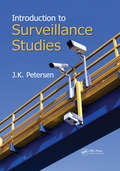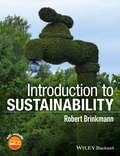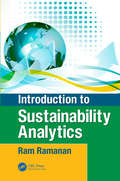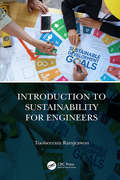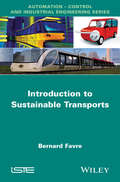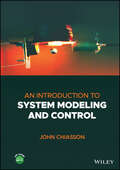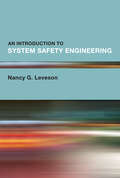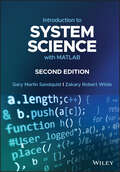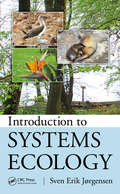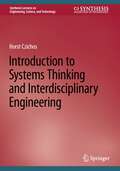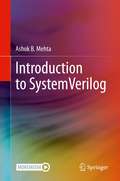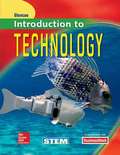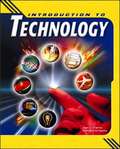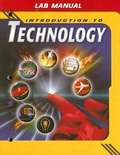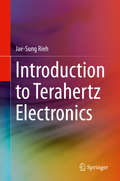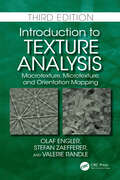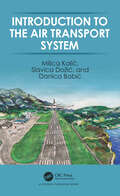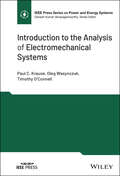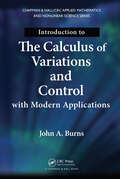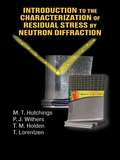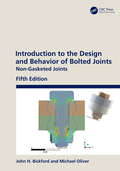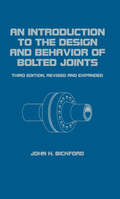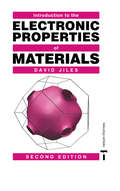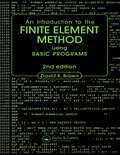- Table View
- List View
Introduction to Surveillance Studies
by J.K. PetersenSurveillance is a divisive issue one might say it is inherently controversial. Used by private industry, law enforcement, and for national security, it can be a potent tool for protecting resources and assets. It can also be extremely invasive, calling into question our basic rights to freedom and privacy. Introduction to Surveillance Studies explo
Introduction to Sustainability
by Robert BrinkmannIntroduction to Sustainability is the first major textbook to review major themes in the cutting-edge field of sustainability. The book is suitable for introductory interdisciplinary courses on sustainability, as well as those in the fields of geography, geology, sociology, planning, political science, and anthropology. Brinkmann’s book allows students to see the world in new ways while also encouraging them to become part of the change needed to ensure the long-term sustainability of the planet. The text includes material on the development of the field of sustainability; environmental sustainability issues like water, food, and energy; social sustainability themes like environmental justice and transportation; and economic sustainability topics like green businesses and economic development. The book concludes with a chapter on sustainability issues in college and universities. Brinkmann intersperses many fascinating case studies and text boxes that encourage students to deeply explore the material. This is a book that not only organizes the complex field of sustainability, but also encourages students to take action to make the world a better place.
Introduction to Sustainability Analytics
by Raghavan Ram RamananThe roles of corporate and public stewards and the nature of their social contract with society have been changing over the past two centuries, and those changes have accelerated in recent decades. Moreover, with increasing focus on sustainability factors from the marketplace (regulators, investors, financiers, and consumers), corporate sustainability disclosure is shifting from voluntary to vital. Corporate and public stewards are now responsible for their performance and services from cradle-to-grave: they must properly manage corporate social responsibility and integrate it into their global strategies, rather than consider it as merely a moral obligation or a risk/reputation management exercise. <P><P> Sustainability analytics, the critical link between sustainability and business strategy, helps professionals track, trend, and transform sustainability information into actionable insights across the value chain and life cycle, to enhance their sustainability performance and its disclosure. This book, Introduction to Sustainability Analytics, provides corporate and public stewards with a comprehensive understanding of how to determine which sustainability metrics are material to them and relevant to their business, and how to incorporate them into corporate strategy, resource allocation, and prioritization. Focusing on practical decision-making needs, it explains how to value and prioritize initiatives, and how to best allocate necessary resources through several real case studies and practical examples. <P><P> Features: <P><P> Examines pressing issues such as climate change, water scarcity, and environmental justice <P><P> Explains how to develop a business case and global strategy for social responsibility <P><P> Includes both corporate and public policy perspectives on sustainability economics <P><P> Covers emerging regulations on sustainability disclosure and responsible investing
Introduction to Sustainability for Engineers
by Toolseeram RamjeawonIntroduction to Sustainability for Engineers aims to incorporate sustainability into curricula for undergraduate engineering students. The book starts with an introduction to the concept of sustainability, outlining core principles for sustainable development to guide engineering practice and decision making, including key tools aimed at enabling, measuring and communicating sustainability. It also describes concepts as life cycle assessment, environmental economics, related institutional architecture and policy framework, business context of sustainability, and sustainable buildings and infrastructure. Appendices at the end of the book presents a summary of key concepts, strategies and tools introduced in the main text. Five Key Benefits: A comprehensive textbook for engineering students to develop competency in sustainability. Presents a framework for engineers to put sustainability into practice. Presents the link between sustainability and the design process. It shows the application of a sustainable engineering design process for putting sustainability into practice. There are well woven case studies and links to websites for learning in various engineering disciplines. Includes challenging exercises at the end of each chapter that will inspire students and stimulate discussion in the class.
Introduction to Sustainable Transports
by Bernard FavreTransport systems have to meet the mobility needs of people and commodities on all scales, from the local to the global level. Concerns about the energy, fumes and sound emissions produced, and about the safety, service quality, intelligence and lifecycle of the systems, etc. can all be included in a systemic approach. This approach can contribute to the development of sustainable solutions, for individual vehicles as well as for transport systems. Derived from an approach combining the social and physical sciences, these solutions result from the integration of physical objects, services and organizational processes, which involve several actors. Their harmonious organization contributes to the development of more virtuous transport systems for the future of urban and inter-urban mobility.
An Introduction to System Modeling and Control
by John ChiassonA practical and straightforward exploration of the basic tools for the modeling, analysis, and design of control systems In An Introduction to System Modeling and Control, Dr. Chiasson delivers an accessible and intuitive guide to understanding modeling and control for students in electrical, mechanical, and aerospace/aeronautical engineering. The book begins with an introduction to the need for control by describing how an aircraft flies complete with figures illustrating roll, pitch, and yaw control using its ailerons, elevators, and rudder, respectively. The book moves on to rigid body dynamics about a single axis (gears, cart rolling down an incline) and then to modeling DC motors, DC tachometers, and optical encoders. Using the transfer function representation of these dynamic models, PID controllers are introduced as an effective way to track step inputs and reject constant disturbances. It is further shown how any transfer function model can be stabilized using output pole placement and on how two-degree of freedom controllers can be used to eliminate overshoot in step responses. Bode and Nyquist theory are then presented with an emphasis on how they give a quantitative insight into a control system's robustness and sensitivity. An Introduction to System Modeling and Control closes with chapters on modeling an inverted pendulum and a magnetic levitation system, trajectory tracking control using state feedback, and state estimation. In addition the book offers: A complete set of MATLAB/SIMULINK files for examples and problems included in the book. A set of lecture slides for each chapter. A solutions manual with recommended problems to assign. An analysis of the robustness and sensitivity of four different controller designs for an inverted pendulum (cart-pole). Perfect for electrical, mechanical, and aerospace/aeronautical engineering students, An Introduction to System Modeling and Control will also be an invaluable addition to the libraries of practicing engineers.
An Introduction to System Safety Engineering
by Nancy G. LevesonA comprehensive, up-to-date introduction to the foundations of classical safety engineering, with an emphasis on preparing for future challenges.Systems today are orders of magnitude more complex than in the past, and their complexity is increasing exponentially. Preventing accidents and losses in such systems requires a holistic perspective that can accommodate unprecedented types of technology and design. This textbook teaches the foundations of classical safety engineering while incorporating the principles of systems thinking and systems theory. Beginning with the framing and lessons of her classic text, Safeware, Nancy Leveson builds on established knowledge and brings the field up to date, challenging old approaches and introducing new ones. This essential book provides the core information required to build safety-critical systems today and in the future, including coverage of the historical and legal frameworks in which the field operates as well as discussions of risk, ethics, and policy implications. Presents cutting-edge concepts anticipating the safety challenges of the future alongside thorough treatment of historical practices and ideasProvides a comprehensive introduction to the foundations of safety engineeringCovers accident analysis, hazard analysis, design for safety, human factors, management, and operationsIncorporates extensive examples of real-world accidents and applications Ideal for students new to safety engineering as well as professionals looking to keep pace with a rapidly changing field
Introduction to System Science with MATLAB
by Gary Marlin Sandquist Zakary Robert WildeIntroduction to SYSTEM SCIENCE with MATLAB Explores the mathematical basis for developing and evaluating continuous and discrete systems In this revised Second Edition of Introduction to System Science with MATLAB®, the authors Gary Sandquist and Zakary Wilde provide a comprehensive exploration of essential concepts, mathematical framework, analytical resources, and productive skills required to address any rational system confidently and adequately for quantitative evaluation. This Second Edition is supplemented with new updates to the mathematical and technical materials from the first edition. A new chapter to assist readers to generalize and execute algorithms for systems development and analysis, as well as an expansion of the chapter covering specific system science applications, is included. The book provides the mathematical basis for developing and evaluating single and multiple input/output systems that are continuous or discrete. It offers the mathematical basis for the recognition, definition, quantitative modeling, analysis, and evaluation in system science. The book also provides: A comprehensive introduction to system science and the principles of causality and cause and effect operations, including their historical and scientific background A complete exploration of fundamental systems concepts and basic system equations, including definitions and classifications Practical applications and discussions of single-input systems, multiple-input systems, and system modeling and evaluation An in-depth examination of generalized system analysis methods and specific system science applications Perfect for upper-level undergraduate and graduate students in engineering, mathematics, and physical sciences, Introduction to System Science with MATLAB® will also earn a prominent place in libraries of researchers in the life and social sciences.
Introduction to Systems Ecology (Applied Ecology and Environmental Management)
by Sven JorgensenPossibly the first textbook to present a practically applicable ecosystems theory, Introduction to Systems Ecology helps readers understand how ecosystems work and how they react to disturbances. It demonstrates-with many examples and illustrations-how to apply the theory to explain observations and to make quantitative calculations and predictions
Introduction to Systems Thinking and Interdisciplinary Engineering (Synthesis Lectures on Engineering, Science, and Technology)
by Horst CzichosThis concise textbook introduces a systems approach to technology, describing tribological, mechatronic, cyber-physical systems, and the technologic concept of Industry 4.0 to students in a range of engineering domains. “Technology” in this book refers to the totality of human-made, benefit-oriented products, based on engineered combinations of material, energy and information. Dr. Czichos examines technology in this volume in the context of systems thinking with regard to the following main technology areasTechnical systems with “interacting surfaces in relative motion” especially in mechanical engineering, production, and transport; including the analysis of friction-induced energy losses and wear-induced materials dissipation. Technical systems that require a combination of mechanics, electronics, controls, and computer engineering for needs of industry and society. Technical systems with a combination of mechatronics and internet communication. Cyber-physical Systems for the digitalization of Industry in the development project Industry 4.0.Considers technology as combination of the physical world and the digital virtual world of information and communication.Describes the product cycle of technical systems and the corner stones of technology: material, energy and information.Presents a holistic view of technology and engineering.
Introduction to SystemVerilog
by Ashok B. MehtaThis book provides a hands-on, application-oriented guide to the entire IEEE standard 1800 SystemVerilog language. Readers will benefit from the step-by-step approach to learning the language and methodology nuances, which will enable them to design and verify complex ASIC/SoC and CPU chips. The author covers the entire spectrum of the language, including random constraints, SystemVerilog Assertions, Functional Coverage, Class, checkers, interfaces, and Data Types, among other features of the language. Written by an experienced, professional end-user of ASIC/SoC/CPU and FPGA designs, this book explains each concept with easy to understand examples, simulation logs and applications derived from real projects. Readers will be empowered to tackle the complex task of multi-million gate ASIC designs.Provides comprehensive coverage of the entire IEEE standard SystemVerilog language;Covers important topics such as constrained random verification, SystemVerilog Class, Assertions, Functional coverage, data types, checkers, interfaces, processes and procedures, among other language features;Uses easy to understand examples and simulation logs; examples are simulatable and will be provided online;Written by an experienced, professional end-user of ASIC/SoC/CPU and FPGA designs.This is quite a comprehensive work. It must have taken a long time to write it. I really like that the author has taken apart each of the SystemVerilog constructs and talks about them in great detail, including example code and simulation logs. For example, there is a chapter dedicated to arrays, and another dedicated to queues - that is great to have! The Language Reference Manual (LRM) is quite dense and difficult to use as a text for learning the language. This book explains semantics at a level of detail that is not possible in an LRM. This is the strength of the book. This will be an excellent book for novice users and as a handy reference for experienced programmers. Mark GlasserCerebras Systems
Introduction to Technology
by Alan J. Pierce Dennis KarwatkaStudents will discover technology through project-based pedagogy with Glencoe's Introduction to Technology! Teachers and students are offered content that is driven by projects to facilitate hands-on understanding and learning, while academics are integrated in unit-based projects and chapter-based Technology Labs. Students are invited to play and "crack the code" with the Technology Time Machine game while learning the key content of the technology literacy standards. Prepare students for TSA competitive events with prep activities embedded throughout the content and end-of-chapter assessments. Rigorous academic content is fully supported, especially in math, geometry, and science, with STEM activities throughout. Point-of-use academic correlations are included to ease possible academic credit application. Teachers can meet Perkins mandates for academic excellence with extra activities in the Student Edition and in the Project Applications Workbook. Careers profiles, Tech Stars, Imagine This! and Eco Tech features enhance the content with relevant information and challenging activities.
Introduction to Technology (3rd edition)
by Dennis Karwatka Alan J. PierceIntroduction to Technology creates excitement in middle school students about the potential of technology! Introduction to Technology helps students understand and work with technology. The seven units of Introduction to Technology cover: Nature of Technology - why we study technology and its important concepts; Engineering Design - how technology works including design, problem solving, drafting and modeling; Communication, Biotechnology, Manufacturing, Construction and Transportation. Students will learn about technology and do technology.
Introduction to Technology Lab Manual
by Glencoe/McGraw-HillHands-on activities help students understand and apply key concepts.
Introduction to Terahertz Electronics
by Jae-Sung RiehThis book provides a practical guide to terahertz electronics, especially for readers with an electronics background. The author guides readers through the all the key concepts of terahertz electronics, including terahertz sources, detectors, and waveguides, together with reviews on key terahertz applications on spectroscopy, imaging, communication, and radar. This book will serve as a handy reference for graduate students and engineers in the field of terahertz with a viewpoint from electronics.Presents the topic of terahertz from electronics viewpoint;Designed to be particularly helpful for the readers familiar with semiconductor devices and circuits;Enables optics-based terahertz researchers to understand terahertz electronics;Based on the author’s extensive experience from both industry and academia.
Introduction to Texture Analysis: Macrotexture, Microtexture, and Orientation Mapping
by Olaf Engler Stefan Zaefferer Valerie RandleReflecting emerging methods and the evolution of the field, Introduction to Texture Analysis: Macrotexture, Microtexture, and Orientation Mapping keeps mathematics to a minimum in covering both traditional macrotexture analysis and more advanced electron-microscopy-based microtexture analysis. The authors integrate the two techniques and address the subsequent need for a more detailed explanation of philosophy, practice, and analysis associated with texture analysis. The book illustrates approaches to orientation measurement and interpretation and elucidates the fundamental principles on which measurements are based. Thoroughly updated, this Third Edition of a best-seller is a rare introductory-level guide to texture analysis. Discusses terminology associated with orientations, texture, and their representation, as well as the diffraction of radiation, a phenomenon that is the basis for almost all texture analysis. Covers data acquisition, as well as representation and evaluation related to the well-established methods of macrotexture analysis. Updated to include experimental details of the latest transmission or scanning electron microscope-based techniques for microstructure analysis, including electron backscatter diffraction (EBSD). Describes how microtexture data are evaluated and represented and emphasizes the advances in orientation microscopy and mapping, and advanced issues concerning crystallographic aspects of interfaces and connectivity. Offers new and innovative grain boundary descriptions and examples. This book is an ideal tool to help readers in the materials sciences develop a working understanding of the practice and applications of texture.
Introduction to the Air Transport System
by Milica Kalić Slavica Dožić Danica BabićThe book provides deep insights into the operations and business of the air transport system, i.e., airlines, airports, and ATC/ATM (Air Traffic Control/Management). It reviews activities of the air transport operators, functions and processes, as well as the needs and requirements of users and customers in a simple and easy to understand way. A brief description of aviation history, the air transport system development and processes are followed by the elaboration of the aircraft’s elements, masses, payload-range diagrams, and balance. The fundamentals of airports and the ATC/ATM service providers and their contribution to the air transport system are also provided. Moreover, the most important elements in the airport and ATC/ATM system are examined, and the rules, regulations and simplified approaches to how these systems operate are described. The airlines play an important role in the air transport system as users of the airports’ and ATC/ATM service providers. Different business models are presented as well as the fundamentals of airline planning, operations and management (including passenger demand, market segmentation, scheduling, tariffs, alliances, and frequent flyer programs). Besides passenger transport, the book contains an overview and comprehensive guide of the air cargo transport by addressing the key issues such as: the current trends, market characteristics, unit load devices, cargo handling, air cargo documents, and transport of different kind of goods (perishable, live human organs, live animals, dangerous, heavy, etc.).
Introduction to the Analysis of Electromechanical Systems (IEEE Press Series on Power and Energy Systems)
by Paul C. Krause Oleg Wasynczuk Timothy O'ConnellDiscover the analytical foundations of electric machine, power electronics, electric drives, and electric power systems In Introduction to the Analysis of Electromechanical Systems, an accomplished team of engineers delivers an accessible and robust analysis of fundamental topics in electrical systems and electrical machine modeling oriented to their control with power converters. The book begins with an introduction to the electromagnetic variables in rotatory and stationary reference frames before moving onto descriptions of electric machines. The authors discuss direct current, round-rotor permanent-magnet alternating current, and induction machines, as well as brushless direct current and induction motor drives. Synchronous generators and various other aspects of electric power system engineering are covered as well, showing readers how to describe the behavior of electromagnetic variables and how to approach their control with modern power converters. Introduction to the Analysis of Electromechanical Systems presents analysis techniques at an introductory level and at sufficient detail to be useful as a prerequisite for higher level courses. It also offers supplementary materials in the form of online animations and videos to illustrate the concepts contained within. Readers will also enjoy: A thorough introduction to basic system analysis, including phasor analysis, power calculations, elementary magnetic circuits, stationary coupled circuits, and two- and three-phase systems Comprehensive explorations of the basics of electric machine analysis and power electronics, including switching-circuit fundamentals, conversion, and electromagnetic force and torque Practical discussions of power systems, including three-phase transformer connections, synchronous generators, reactive power and power factor correction, and discussions of transient stability Perfect for researchers and industry professionals in the area of power and electric drives, Introduction to the Analysis of Electromechanical Systems will also earn its place in the libraries of senior undergraduate and graduate students and professors in these fields.
Introduction to the Calculus of Variations and Control with Modern Applications
by John A. BurnsIntroduction to the Calculus of Variations and Control with Modern Applications provides the fundamental background required to develop rigorous necessary conditions that are the starting points for theoretical and numerical approaches to modern variational calculus and control problems. The book also presents some classical sufficient conditions a
Introduction to the Characterization of Residual Stress by Neutron Diffraction
by M.T. Hutchings P.J. Withers T.M. Holden Torben LorentzenOver the past 25 years the field of neutron diffraction for residual stress characterization has grown tremendously, and has matured from the stage of trial demonstrations to provide a practical tool with widespread applications in materials science and engineering. While the literature on the subject has grown commensurately, it has also remained
Introduction to the Design and Behavior of Bolted Joints: Non-Gasketed Joints
by John H. Bickford Michael OliverThe fully updated Fifth Edition of John H. Bickford's classic work, updated by Michael Oliver, provides a practical, detailed guide for the design threaded bolted joints, the tightening of threaded joints, and the latest design procedures for long-term life. New sections on materials, threads, and their strength have been added, and coverage of FEA for design analysis is now included. Referencing the latest standards, this new edition combines fastener materials, explanation of how fasteners are made, and how fasteners fit together, supplementing the basic design coverage included in previous versions of this authoritative text. Introduction to the Design and Behavior of Bolted Joints: Non-Gasketed Joints will be of interest to engineers involved in the design and testing of bolted joints.
An Introduction to the Design and Behavior of Bolted Joints, Revised and Expanded (Mechanical Engineering Ser.)
by John BickfordOffering a broad-based review of the factors affecting the design, assembly and behaviour of bolted joints and their components in all industries, this work details various assembly options as well as specific failure modes and strategies for their avoidance. This edition features material on: the contact stresses between bolt head or nut face and the joint; thread forms, series and classes; the stiffness of raised face flange joints; and more.
Introduction to the Electronic Properties of Materials
by David C. JilesElectronic materials provide the basis for many high tech industries that have changed rapidly in recent years. In this fully revised and updated second edition, the author discusses the range of available materials and their technological applications.Introduction to the Electronic Properties of Materials, 2nd Edition presents the principles of the behavior of electrons in materials and develops a basic understanding with minimal technical detail. Broadly based, it touches on all of the key issues in the field and offers a multidisciplinary approach spanning physics, electrical engineering, and materials science. It provides an understanding of the behavior of electrons within materials, how electrons determine the magnetic thermal, optical and electrical properties of materials, and how electronic properties are controlled for use in technological applications. Although some mathematics is essential in this area, the mathematics that is used is easy to follow and kept to an appropriate level for the reader.An excellent introductory text for undergraduate students, this book is a broad introduction to the topic and provides a careful balance of information that will be appropriate for physicists, materials scientists, and electrical engineers.
An Introduction to the Engineering of Fast Nuclear Reactors
by Anthony M. JuddThis book is an invaluable resource for both graduate-level engineering students and practicing nuclear engineers who want to expand their knowledge of fast nuclear reactors, the reactors of the future! The book is a concise yet comprehensive introduction to all aspects of fast reactor engineering. It covers topics including neutron physics; neutron flux spectra; flux distribution; Doppler and coolant temperature coefficients; the performance of ceramic and metal fuels under irradiation, structural changes, and fission-product migration; the effects of irradiation and corrosion on structural materials, irradiation swelling; heat transfer in the reactor core and its effect on core design; coolants including sodium and lead-bismuth alloy; coolant circuits; pumps; heat exchangers and steam generators; and plant control. The book includes new discussions on lead-alloy and gas coolants, metal fuel, the use of reactors to consume radioactive waste, and accelerator-driven subcritical systems.
Introduction to the Finite Element Method using BASIC Programs
by D.K. BrownThis updated, revised and extended edition gives a comprehensive introduction to the understanding and use of the finite element method as applied to structures. The text methodically covers all the important bridges in understanding up to and including the introduction of isoparametric elements.
